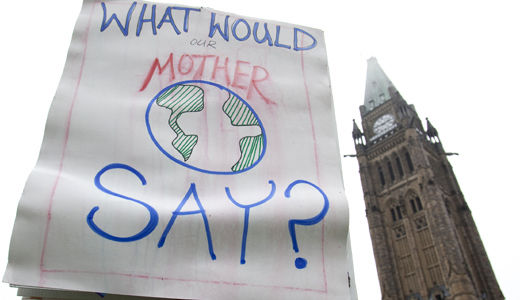
The latest round of meetings, both on climate change and the United Nations Climate Change Summit on Dec. 1-2, are taking place in Doha, Qatar. They follow similar meetings over the past years in Cancun, Bali, and Copenhagen. All these meetings are supposed to negotiate an international climate change agreement to follow the Kyoto Accords, which are due to expire.
Each conference hears reports about how much the world is depending on these gatherings to develop cooperative international approaches to mitigate and adjust to climate change. Each conference hears reports, based on the latest climate change science, that the outlook is getting worse and worse, that dire consequences from climate change are already upon us, that every delay means that the steps we will need to take are more difficult and more expensive. No one knows for certain exactly how bad it will get, but the latest calculations are for warming of from 4 to 6 degrees Celsius (7.2 degrees Fahrenheit or more) by the end of the century. That much warming has the potential to be catastrophic for major sections of the human race.
Nonetheless, agreement has eluded the participants. And there is little hope that the results of this weekend’s conference will be any better than the last ones, which ended with vague statements and promises of future negotiations.
Partly it is a matter of political will. Partly it is a matter of confronting the power of the oil, gas, and coal industries. Partly it is a matter of overcoming inertia and beginning the process, even before complete agreement is reached. And partly it is because real differences over real issues complicate the negotiations.
Where to place the burden: per country or per capita?
A key battle is over who has to shoulder the burdens of climate change. One aspect of the battle is about how we measure the relative impacts of carbon dioxide emissions. Some countries argue that we should use the measure of carbon dioxide emissions per capita – dividing the net emissions by the number of people in a given country. This would have the effect of placing a greater burden on those countries that emit the most, given their population.
Others argue for using total emissions by country. For example, in opening the conferences in Doha, Qatar’s former oil minister proclaimed that the measure by country should be used. Abdullah Bin Hamad Al-Attiyah told reporters, “We should not concentrate on the per capita (emissions), we should concentrate on the amount from each country.” This would have the effect of letting many countries that emit the most per capita off the hook.
Some countries, like the U.S., are at or near the top no matter how you measure emissions, but others such as Qatar, which has the highest per capita rate of emissions in the world and whose economy is based on oil and gas revenues, have much smaller populations and so would benefit much more from using total current emissions by country.
On the other hand, China is now the largest single contributor to the emission of climate change gases – but it still has a far lower per capita emission rate. If we use total current emissions, China would have to bear a large share of the burden, even though its per capita emissions are still far below those of the U.S., Australia, and other industrially developed countries.
An additional problem with per capita measures is that emissions are not divided equally among all citizens – the poorest emit the least, and some rich people emit far greater amounts. Per capita measures are a blunt instrument, which ignore the class divisions within societies.
How to measure responsibility: current emissions or historical ones?
Another difficult dispute is over whether to base our division of responsibility on just current emissions, or to include the emissions over the last 150 years of industrialization. Carbon dioxide and other greenhouse gas emissions accumulate in the atmosphere and last for many decades or longer, so those countries which have been industrialized the longest have, by that measure, contributed most to the problems we now face, and so should bear the greatest burden of cost.
By this measure, the U.S., Western European countries, Australia, and Japan have historically done the most damage, have contributed more to our current problems than would be shown if we only take current emissions into account. Many developing countries argue that those who have benefitted the most from the emissions in the past should pay the most now. They argue that developing countries can’t be restricted from developing more, improving the lives of their citizens more, just because they lack the same level of industrial development.
This would have the effect making it easier for China and some other developing countries such as Brazil, because while their current emissions are relatively high, they have not contributed much in the past to the problem.
On the other hand, developed countries including the U.S. argue against per capita measures and against any inclusion of historical emissions, since that would require them to make bigger, more expensive changes faster and provide technical and financial support to poorer countries.
Should there be compensation for countries that have resources that benefit the world?
Some countries have resources, especially rainforests, which are the “lungs of the world” and which the world desperately needs those countries to stop cutting down. The Amazon forest, primarily in Brazil, and the massive forests in Indonesia are resources that are needed by the entire world. However, without some form of compensation, those countries are unlikely to reduce the destruction of these forests.
In Brazil, forests are being cut down for cattle farms, basically. In Indonesia, forests are being cut down to make room for more palm oil plantations. Those represent a great deal of development, economic growth, for those countries (though of course the economic benefits are not shared equally).
So there have been various efforts to develop schemes by which industrially developed countries would financially compensate those countries for maintaining their forests. There are tricky issues, but some progress has been made in solving them, and some agreements have begun to be put in place. But not enough to stop deforestation, which on its own contributes to greenhouse gas emissions and eliminates the positive benefits of robust forests including that they take carbon out of the atmosphere.
Pay now or pay later?
Adapting our economies to climate change is an expensive proposition. Many approach this in a penny-wise, pound-foolish way.
For example, it would be quite expensive to install a system of gates which would protect New York City and its harbor from the storm surges which are already impacting them – maybe as much as $5 billion to $6 billion (Britain already installed this kind of system on the Thames River to protect London). However, the costs of recovery from Hurricane Sandy in New York City alone will greatly exceed that.
So we are going to pay, one way or another, sooner or later. It makes much more sense to take proactive measures, before too much damage is done. The Netherlands is a world leader in instituting such measures, crucial since so much of that country lies below sea level.
If we just wait for storms, extreme weather events, increasing heat waves, and massive droughts to force us to pay even greater amounts, we will lose the chance to pay a bit less, even though that would require that we pay sooner.
These kinds of choices are replicated worldwide, depending on geography, level of development, and political will.
Environmental justice
Just as there are issues of environmental justice within the U.S. – such as minority communities which “just happen” to be where incinerator plants are located – there are international environmental justice issues.
The countries which are already suffering the most from climate change, and will continue to do so in the foreseeable future, are also mostly the poorest countries in the world, including many East African countries and Asian countries such as Bangladesh. They get a triple whammy – first from their geography which places them in the path of rising seas or increased droughts, second from being less industrially developed, meaning they have fewer resources to deal with climate change, and third from having historically contributed the least greenhouse gas emissions.
Some Pacific Ocean island nations such as the Maldives will be the first to actually totally disappear, since they are already living so close to sea level, and thus face the greatest threat from rising waters.
Path to solutions
The route to solutions lies first of all in recognizing and acknowledging our common humanity.
As thorny as these roadblocks to agreement are, we all inhabit this one planet. Especially with globalization, what happens anywhere affects everyone. We share a common future, and it is up to all nations to help ameliorate the negative consequences of the industrial path followed by most of the world.
As we increasingly see, climate change is affecting us. More than half the U.S. is suffering from prolonged drought. The entire Eastern seaboard was pounded by Hurricane Sandy. Wildfires in the western U.S. are reaching record-setting temperatures, burning more intensely than ever before and requiring much longer to recover from. We can’t solve even our own problems without helping the world solve this worldwide challenge, and without making major changes ourselves, to our systems of production, distribution, transportation, and agriculture.
And while the financial burden shouldn’t fall equally, we all share the need to address climate change, so we all have a part to play in building a healthy environment so we can have a healthy humanity.
Photo: A sign held by a demonstrator for recognition of climate change on Parliament Hill, proving that the environment is of international concern. Pawel Dwulit/AP Photos, Canadian Press










